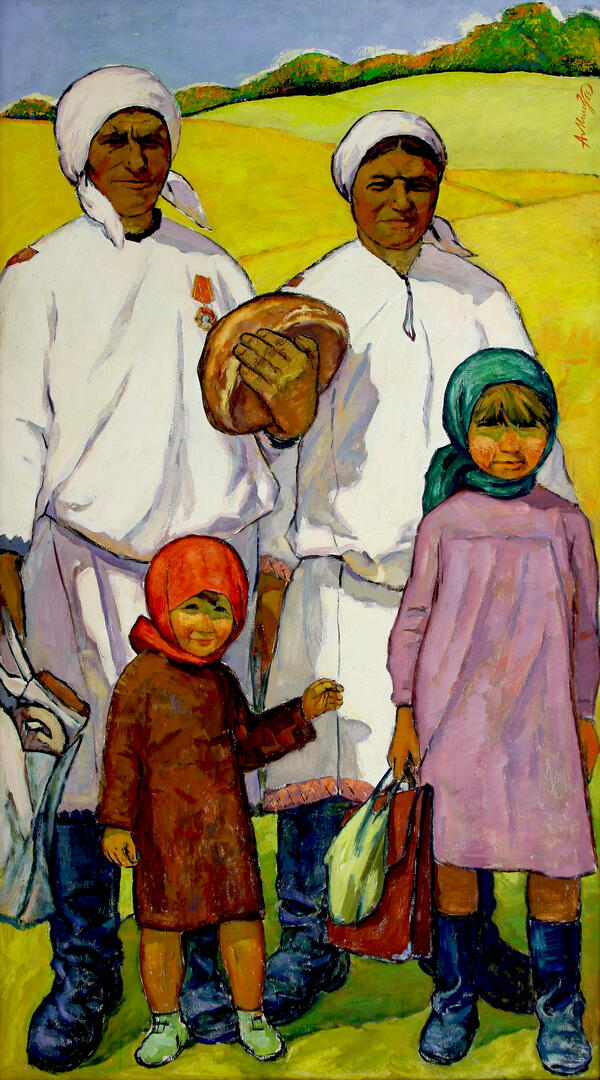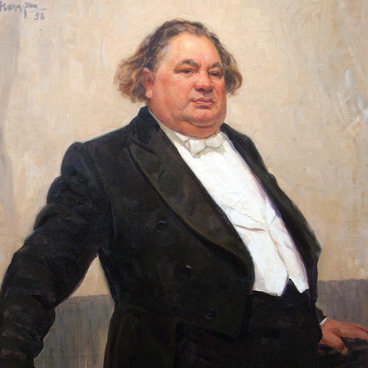The artist Anatoly Misyura was born in Ukraine and graduated from the Odessa Art School in 1958. Since 1960, the painter lived in Saransk and worked in the genres of thematic painting, portrait, landscape and still life. As an artist and worker of Mordovian art-industrial studios, Anatoly Misyura designed stands, exhibitions, and interiors and facades of public buildings. The artist’s works have been displayed in numerous exhibitions — from regional to national and All-Russian ones. Anatoly Misyura significantly contributed to the development of the fine arts of Mordovia.
Anatoly Misyura relied on the artistic principles of the Severe style. This trend in Soviet realistic painting appeared in the late 1950s — early 1960s. During this period, artists aspired to a monumental all-encompassing display of life, looking for new forms and means of artistic representation.
The Severe style painters depicted the heroes of everyday work without embellishments and ideological optimism of the era. The focus was on the harsh, plain romance of everyday life and people with their inner energy, will to live, and perseverance in overcoming obstacles.
The Anatoly Misyura’s painting “Moksha Collective Farmers” also celebrates a simple worker, although in a slightly different way that deviates from the works of this artistic movement.
The easel work of Anatoly Misyura is monumental. His heroes are like trees: strong and mighty, they grow out of the ground. In the canvas, we can see the contrast of large color planes, the rigor of silhouettes, the brevity of the image, accuracy and a small number of details. All these features liken the picture to a poster.
The color palette is rich, juicy, and bright. The color accents, calm smiles of women, and firm poses create a solid optimistic image, which is consistent with social realism.
The artist combines in this work the spirit of the Soviet era and how this spirit is reflected in the culture and life of a particular people. On the one hand, the image of women in stylized national costumes bears witness to the preservation of traditions. On the other hand, the depiction of children in the clothes of the new Soviet era shows a change in the Mordovian value system.
Anatoly Misyura relied on the artistic principles of the Severe style. This trend in Soviet realistic painting appeared in the late 1950s — early 1960s. During this period, artists aspired to a monumental all-encompassing display of life, looking for new forms and means of artistic representation.
The Severe style painters depicted the heroes of everyday work without embellishments and ideological optimism of the era. The focus was on the harsh, plain romance of everyday life and people with their inner energy, will to live, and perseverance in overcoming obstacles.
The Anatoly Misyura’s painting “Moksha Collective Farmers” also celebrates a simple worker, although in a slightly different way that deviates from the works of this artistic movement.
The easel work of Anatoly Misyura is monumental. His heroes are like trees: strong and mighty, they grow out of the ground. In the canvas, we can see the contrast of large color planes, the rigor of silhouettes, the brevity of the image, accuracy and a small number of details. All these features liken the picture to a poster.
The color palette is rich, juicy, and bright. The color accents, calm smiles of women, and firm poses create a solid optimistic image, which is consistent with social realism.
The artist combines in this work the spirit of the Soviet era and how this spirit is reflected in the culture and life of a particular people. On the one hand, the image of women in stylized national costumes bears witness to the preservation of traditions. On the other hand, the depiction of children in the clothes of the new Soviet era shows a change in the Mordovian value system.


